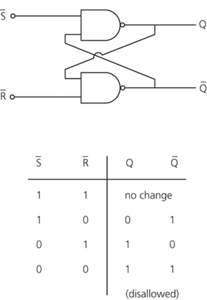An electronic circuit that has two stable states. It is switched from one stable state to the other by means of a triggering pulse. They are extensively used as logic circuits in computers.
The movement (transverse diffusion) of a lipid molecule from one surface of a lipid bilayer membrane to the other, which occurs at a very slow rate. This contrasts with the much faster rate at which lipid molecules exchange places with neighbouring molecules on the same surface of the membrane (lateral diffusion).
An electronic circuit element that is capable of exhibiting either of two stable states and of switching between these states in a reproducible manner. When used in logic circuits the two states are made to correspond to logic 1 and logic 0. Flip-flops are therefore one-bit memory elements and are frequently used in digital circuits.
The simplest form is the RS flip-flop; an implementation using NAND gates is shown in the diagram together with the flip-flop’s truth table. A logic 1 on one of the two inputs either sets the Q output to logic 1 or resets Q to logic 0. Output Q̄; is the logical complement of Q. When R̄ and S̄ are both logic 1 (which is equivalent to R and S both logic 0), Q does not change state. The situation of both R̄ and S̄ at logic 0 is ambiguous and is avoided in more complex flip-flop implementations (see JK flip-flop). The outputs of this (and other) flip-flops are not just functions of the inputs but depend on both inputs and outputs. The device is thus a simple sequential circuit.
Extra logic gating may be included in the RS device, and in more complex flip-flops, to allow a clock signal to be input to the flip-flop, so producing a clocked flip-flop (see clock). The Q output will not then change state until an active edge of the clock pulse occurs (edge-triggered device) or a complete clock cycle has occurred (pulse-triggered device). Provision may also be made to set up a given output regardless of the state of the inputs.
Various forms of flip-flop are available to perform specific functions; these include JK, D, T, and master-slave flip-flops. Flip-flops are important as memory devices in digital counters. The RS flip-flop is often considered to be the universal flip-flop since it forms the basic building block for more sophisticated implementations. JK, master-slave, and D flip-flops are all available in the standard TTL and CMOS series of integrated-circuit components.

Flip-flop. RS flip-flop, logic diagram, and truth table
A bistable multivibrator circuit that usually has two inputs corresponding to the two stable states. It is so called because application of a suitable input pulse causes the device to ‘flip’ into the corresponding state and remain in that state until a pulse on the other input causes it to ‘flop’ into the other state.
Flip-flops are widely used in computers as counting and storage elements and several types have been developed. Flip-flops as described above are unclocked and are triggered directly by the input pulses. Clocked flip-flops have a third input to which a clock pulse is applied. The output state of the device is determined by the state of the inputs at the moment a clock pulse is applied. The basic types of flip-flops are described below.
A D-type flip-flop (‘D’ stands for delay) is a clocked flip-flop with a single input whose output is delayed by one clock pulse: if a logical 1 appears at the input, a logical 1 will appear at the output one clock pulse later.
An R-S flip-flop is a flip-flop whose inputs are designated R and S. The outputs corresponding to the various input combinations are shown in the table of Fig. a. Logical 1s should not be allowed to appear on the inputs together.

(a) Clocked R–S flip-flop
Input
Output
R
S
Q
0
0
no change, same as previous state
1
0
1
0
0
1
0
1
1
1
indeterminate
A J-K flip-flop is a flip-flop whose inputs are designated J and K (Fig. b). These devices are almost invariably clocked and their outputs are the same as the R-S type except when logical 1s appear together at the inputs. In these circumstances the device changes state. The J-K flip-flop together with the D-type flip-flop are the most useful types of flip-flop.

(b) Clocked J–K flip-flop
J
K
Q
0
0
no change
0
1
0
1
0
1
1
1
toggle
An R-S-T flip-flop has three inputs designated R, S, and T. The R and S inputs produce outputs as described above. Application of a pulse to the T input causes the device to change state.
A T flip-flop has only one input. Application of a pulse to this input causes the device to change state.
The movement (transverse diffusion) of a lipid molecule from one surface of a lipid bilayer membrane to the other, which occurs at a very slow rate. This contrasts with the much faster rate at which lipid molecules exchange places with neighbouring molecules on the same surface of the membrane (lateral diffusion).
- entomology
- entomophily
- Entoprocta
- entrainer
- entrainment
- entrance and exit losses
- entrenched meander
- entrenchment
- entreprenerd
- entrepreneur
- entrepôt
- Entrez
- entropy
- entropy coding
- entropy(Shannon entropy)
- entry
- entry interface
- entry length
- entry point
- entry time
- entry tunnel
- Entscheidungsproblem
- enumerable
- enumeration
- enumeration district